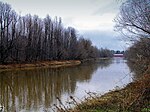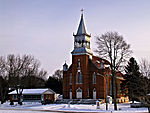Venise-en-Québec
Incorporated places in Le Haut-Richelieu Regional County MunicipalityMunicipalities in QuebecPages with non-numeric formatnum arguments

Venise-en-Québec (French pronunciation: [vəniz ɑ̃ kebɛk]) is a municipality in the province of Quebec, Canada, located at the north end of Lake Champlain in the Regional County Municipality of Le Haut-Richelieu. The population as of the Canada 2021 Census was 1,899.
Excerpt from the Wikipedia article Venise-en-Québec (License: CC BY-SA 3.0, Authors, Images).Venise-en-Québec
Avenue de Venise Est,
Geographical coordinates (GPS) Address Nearby Places Show on map
Geographical coordinates (GPS)
| Latitude | Longitude |
|---|---|
| N 45.083333333333 ° | E -73.133333333333 ° |
Address
Camping Plage Venise
Avenue de Venise Est
J0J 2K0
Quebec, Canada
Open on Google Maps








